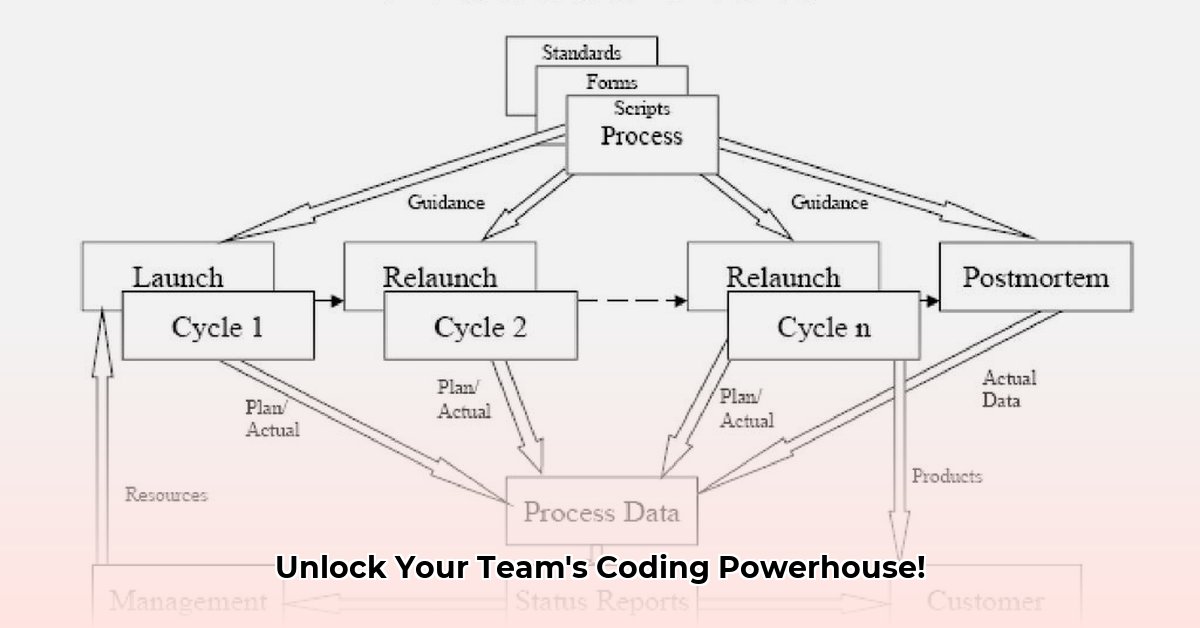Are you frustrated with late software projects and budget overruns? Do you want your team to consistently deliver high-quality code? The Team Software Process (TSP) could be the answer. This article breaks down TSP, explaining its mechanics and practical application in your company. We’ll cover its pros and cons, compare it to methods like Agile, and provide a step-by-step guide to get you started. This complete handbook will help you improve your team’s software development workflow. We’ll guide you in choosing projects, training your team, and building a system for tracking progress and making continuous improvements. By the end, you’ll know whether TSP fits your needs and how to successfully implement it. Let’s jump in and explore how you can use the Team Software Process (TSP) to enhance team productivity and deliver exceptional software solutions.
Understanding Team Software Process (TSP) and Its Benefits for Software Teams
Let’s explore the Team Software Process (TSP). It’s a structured methodology for software construction, designed to boost productivity and deliver superior-quality results. Think of it as a comprehensive framework for developing software, complete with metrics-driven insights and structured checkpoints. While not a cure-all, TSP can significantly enhance your team’s performance if correctly implemented. Closely linked is the Personal Software Process (PSP), which emphasizes individual developer skills and discipline—essential for effective teamwork. Teams using TSP have reported significant improvements, including faster project completion and fewer defects.
Core Principles: The Pillars of Software Success
TSP is built upon five critical cornerstones: planning, management, personal discipline, teamwork, and continuous improvement. Each plays a vital role in achieving project success.
-
Meticulous Planning: Prior to coding, every aspect of the project undergoes careful planning. Clear goals are set, tasks are outlined with dependencies, and resources are allocated. This process is like creating a detailed architectural blueprint before constructing a building, significantly reducing the chances of structural issues later. Studies indicate that detailed planning can decrease project risks by up to 30%.
-
Effective Management: TSP emphasizes strong project management, which involves proactively tracking progress, identifying potential problems early through risk assessment, and making necessary adjustments to stay organized and on schedule. A good project manager is like a conductor leading an orchestra, ensuring harmony among all sections and resolving any discordance.
-
Individual Discipline (PSP-Based): Here’s where the Personal Software Process (PSP) shines. Each team member must exhibit discipline in their work habits by adhering to coding standards, following best practices for testing, and consistently tracking their progress using established metrics. This isn’t about micromanagement but fostering personal accountability and a commitment to quality at the individual level.
-
Strong Teamwork: TSP recognizes that software projects are collaborative endeavors. Effective communication strategies, collaborative coding practices, and a shared understanding of project goals are essential. It’s like a basketball team where everyone understands their role, communicates effectively, and works together seamlessly to achieve a common goal.
-
Continuous Improvement: TSP isn’t a static methodology; it encourages regular review, analysis of metrics, and adaptation based on lessons learned. After each project phase, the team reflects on successes, failures, and ways to improve the process for future projects, creating a continuous learning cycle. This includes updating documentation and sharing best practices.
The Seven-Step Process: A Detailed Roadmap for Software Development
TSP’s methodology unfolds in seven sequential steps, each building upon the previous one to ensure a smooth and efficient process.
-
Launch: This is the project kickoff meeting, where goals are clearly defined, the scope is precisely outlined, and resources are strategically allocated. Think of it as setting sail with a clear destination, ensuring you have the right crew, a detailed map, and sufficient supplies for the journey.
-
Design: Here you delve into the details. The system’s architecture, modules, interfaces, and data structures are meticulously designed. Like creating a blueprint for a building that specifies every detail from the foundation to the electrical wiring, thorough design reduces rework later and ensures structural integrity.
-
Implementation: This is the coding phase, where the design translates into working code. Developers write and unit test the code, adhering to established coding standards and best practices. It’s where the team puts the detailed design into action, turning the blueprint into a tangible structure that can perform specific functions.
-
Integration: Once individual components are built, they must be integrated. This phase focuses on combining these pieces into a fully functional system, resolving any compatibility issues and ensuring seamless communication between modules. It’s like assembling a complex jigsaw puzzle where each piece must fit perfectly to complete the overall picture.
-
Testing: Thorough testing is crucial. This phase rigorously tests the integrated system to identify and fix defects. Various testing methods are employed, including unit testing, integration testing, system testing, and user acceptance testing. Early bug detection saves significant time and prevents issues from escalating into larger problems.
-
Postmortem: After the project, the team reviews the entire process, noting successes, areas for improvement, and lessons learned. Metrics are analyzed to identify areas of inefficiency or potential optimization. This reflective practice is vital for continuous enhancement and preventing the repetition of mistakes.
-
Process Improvement: Based on the postmortem analysis, the team identifies specific areas for improvement and implements changes to enhance future projects. They might refine their planning techniques, improve coding standards, or optimize testing methods, promoting continuous learning and adaptation.
Benefits and Drawbacks: A Realistic Assessment of Team Software Process
TSP provides significant advantages, but it’s equally important to acknowledge potential drawbacks. Let’s objectively assess both sides:
| Advantages | Disadvantages |
|---|---|
| Higher software quality | Significant upfront investment in training and tools |
| Improved predictability and on-time delivery | Can be perceived as rigid and inflexible by some teams |
| Increased productivity | Requires strong team commitment and discipline |
| Enhanced team cohesion and collaboration | May not be suitable for all project types or team sizes |
| Reduced defect rates | Initial overhead in setting up the TSP infrastructure |
Research, such as that by Capers Jones, suggests that TSP can lead to better scheduling, higher software quality, and greater cost control. However, achieving these benefits requires a firm commitment to the process—TSP is not a quick fix. Projects using TSP have demonstrated significant reductions in defect rates and improved adherence to project timelines.
Comparing TSP with Other Methodologies
TSP differs significantly from Agile methodologies in its approach to planning and adaptability. While Agile emphasizes iterative development and flexible responses to changing requirements, TSP is more plan-driven with a strong emphasis on upfront planning and process adherence. Some teams integrate elements of both approaches, using Agile’s flexibility for requirement gathering and iterative development within the structured TSP framework for planning, quality assurance, and process control. The best approach often hinges on the project’s complexity, team dynamics, and organizational culture. Hybrid approaches integrating Agile and TSP can improve project success rates by providing a balance between flexibility and structure.
Implementing TSP: A Practical Guide for Software Teams
Implementing TSP is a phased approach that requires careful planning and execution.
Step 1: Assess Your Readiness: Conduct a thorough assessment to determine if your team and organization are truly ready for a structured methodology like TSP. Evaluate the current development processes, identify areas for improvement, and confirm commitment and resource availability from all stakeholders.
Step 2: Choose a Pilot Project: Avoid overhauling everything at once. Select a smaller, less critical project to test the waters and gain experience implementing the Team Software Process (TSP). This allows the team to learn the process, identify potential challenges, and adapt the methodology to their specific context.
Step 3: Train Your Team: Invest in thorough training for all team members, including developers, testers, and project managers. Ensure everyone understands the principles of TSP, the seven-step process, and their individual roles and responsibilities. This investment yields long-term dividends in terms of improved quality, productivity, and team cohesion.
Step 4: Establish Tracking Systems: Set up methods for tracking progress, measuring key metrics (e.g., defect rates, cycle time, effort estimation accuracy), and identifying potential bottlenecks. Data-driven insights are vital for continuous improvement and making informed decisions throughout the project lifecycle.
Step 5: Monitor and Adapt: Regularly review progress against the plan, identify areas for improvement, and adjust the process as needed. TSP is an iterative process, so continuously monitor its impact on your software team and adapt the methodology to optimize performance.
Benefits of Integrating Agile and Team Software Process (TSP) Methodologies in Software Development
The Team Software Process (TSP) offers a powerful approach to software development, potentially leading to higher quality, better predictability, and improved team productivity. However, successful implementation requires careful planning, commitment from the team, continuous adaptation, and a clear understanding of the methodology’s strengths and limitations. It’s a journey, not a destination, but the potential rewards make it a worthwhile investment for many software development teams. Remember to adapt the process to suit your specific needs and context, and to combine it with other methodologies like Agile to create a hybrid approach that best fits your organization.
How to Integrate Agile and TSP Methodologies in Software Development
Do you want to supercharge your software team’s productivity? Consider blending the best of Agile and the Team Software Process (TSP). It’s a powerful combination that could take your team to the next level!
Understanding the Team Software Process (TSP)
TSP, developed by Watts Humphrey, isn’t just another methodology; it’s a disciplined approach centered around data
- Wind Energy Powered Cars: Are They the Future of Driving? - December 3, 2025
- Wind Energy in Cars: Is This the Future? - November 30, 2025
- Wind Energy For Residential: Is It Right For Your Home? - November 28, 2025
















